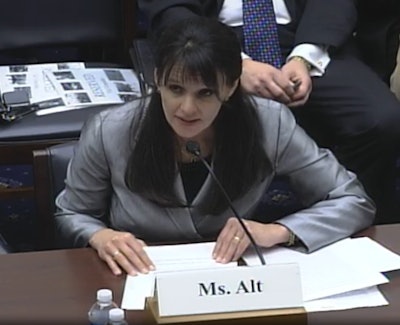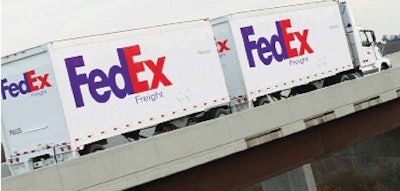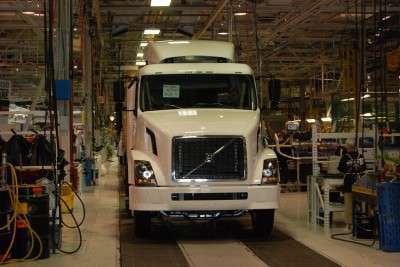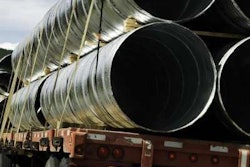When it comes to trucks and highways, federal policy makers are needlessly shooting the U.S. economy in the foot, a panel who represented trucking, manufacturing and transportation planning told the House highway subcommittee Thursday. And, for many of the committee members who asked questions or commented, the experts’ arguments were persuasive.
 Volvo Group’s Susan Alt testifies before House highways subcommittee Thursday.
Volvo Group’s Susan Alt testifies before House highways subcommittee Thursday.The question remains, however: Will Congress act to include changes in federal truck size and weight limits, along with making adjustments in the way the trucking industry pays its share of essential highway improvement costs, in the next surface transportation reauthorization?
The House Transportation subcommittee on Highways and Transit hearing, “Improving the Nation’s Highway Freight Network,” was convened to examine these and related issues.
Henry Maier, president and CEO of FedEx Ground, did the basic math and his opening testimony provided a real-world foundation for much of the hearing’s subsequent discussion.
The condition of the transportation system “absolutely, positively” affects the nation’s ability to compete globally, Maier began. And highways are “the bedrock” of the system, with truck carrying more the two-thirds of the domestic freight tonnage – and with that amount expected to double by 2035.
“If we think traffic congestion is bad today, imagine twice as many trucks on our highways, not to mention more passenger vehicles,” Maier said.
Already, congestion in 498 American cities cost the economy $121 billion in 2011, up 500 percent from an inflation-adjusted $24 billion in 1982, according to a study.
And trucking absorbs more than 20 percent of those costs, which must then be passed along to customers and, ultimately, to consumers.
Additionally, the deterioration of highways and bridges is reaching “crisis proportions.”
“As a business whose customers rely on us for fast and reliable service, we can attest that impassable roads and bridges lead to increased costs, service delays and untold equipment damage,” Maier said, and he later cited deteriorating bridge conditions in Pennsylvania as an example, leading to reduced truck weight limits – resulting in more truck miles, “more costs and more carbon.”
A FedEx solution: modernizing U.S. truck equipment standards. Specifically, Maier cited the advantages of twin, 33-foot trailers on all federal highways – up from the current 28-foot standard which was established more than 30 years ago.
“This solution does not, and I repeat, does not require any change to gross vehicle weight,” Maier said.
And just that basic adjustment will significantly reduce the number of vehicles, trips and miles required to move freight.

Industry-wide, that equals up to 1.8 billion fewer miles driven, more than 300 million gallons of gasoline saved and $2.6 billion in reduced costs annually.
“This innovation promises to deliver tremendous value, but it cannot be implemented without Congress modernizing our transportation policy,” Maier said.
Indeed, there’s an “underestimation” of the new technology that has made trucks safer and more efficient than ever before, suggested Susan Alt, Volvo Group senior vice president for public affairs.
“With existing infrastructure, we can already move more freight with less fuel and less emissions, and with fewer drivers – and we can do that today with some policy changes,” Alt said. “Throughout the rest of the world, Volvo Group already provides trucks that haul longer, heavier freight – safely.”
Just in time
And while Volvo has a clear, direct interest in truck-related policy, Alt’s testimony focused on the importance of the transportation system to Volvo as a global manufacturer that employs more than 12,000 people in the U.S., and that has invested more than $1.5 billion in facilities here in the last 10 years.
While Volvo relies on the transportation network to deliver more than 50,000 truckloads of material to its plants each year, the communities in which Volvo operates rely on those plants as a leading employer, providing the well paying jobs that, in turn, support local retailers and restaurants.
So it’s important that Volvo’s American manufacturing operations remain competitive globally, and that means being efficient in an age of “just in time” inventory management, production and delivery of finished goods.
Additionally, she noted a 20 percent “cost disadvantage” to doing business in the U.S., making investing and improving the infrastructure all the more critical.
“There are disturbances we can plan for, but what we cannot control are unexpected delays due to congestion – this is where we get in real trouble,” Alt said. “When a truck is caught in a traffic jam and can’t make his delivery, the ripple effect of one late delivery can be costly. It means we don’t build the product on time – tying up capital; it means the product will be re-worked – tying up man-hours and not following manufacturing-quality processes; it means sending workers home early; it means not delivering to the customer on time and hurting our competitiveness – all because of that one missed shipment.”
While noting the importance of the Interstate system, Alt cited specifically the I-81 corridor in the East, near which four Volvo facilities are located. Hilly terrain and congestion led to frequent accidents, resulting in production delays at Volvo’s largest plant. Since the addition of a third truck lane on the Interstate, however, deliveries using the route have shown “marked improvement.”
“This is a real-world example of savings that directly benefits our customers,” Alt said. “Logistics is all about planning. Congress needs to provide a long-term plan, or America will suffer.”
Truck productivity
Questioning from the committee allowed Maier and Alt to reinforce the position that trucking depends on good highways – and the nation depends on trucking.
Asked about the safety of more productive truck configurations, Maier explained that FedEx has been running the twin 33-foot trailers in Florida since 2010, some 500,000 miles with no accidents.
“They’re 100 percent safe,” Maier said. “The drivers who participate have told us they believe these trailers are safer than the 28s because they tend to be more stable and they track better. The biggest way to reduce congestion on our highways is to allow longer trailers. We just need Congress to change the policy so we can run them nationwide.”
Another panelist confirmed the advantages of larger trucks – when a program is carefully considered and evaluated.
Mark Gottlieb, secretary of the Wisconsin Department of Transportation, explained that Wisconsin completed a comprehensive truck size and weight study in 2009, looking at the economic gains compared to potential risks and infrastructure damage.
In each of six different truck configurations examined, the study found net benefits in safety, productivity and pavement conditions.
“We have seen significant efficiencies and economic benefits,” Gottlieb said, pointing out that Wisconsin is home to global agriculture and timber industries. “If we had the flexibility to extend that to Interstate system, we would want to make the same data-driven analysis about safety and infrastructure protection. But I think there would be a force-multiplier effect there as well.”
And Rep. Mike Michaud of Maine even got in on the discussion, noting an ongoing test in his state, and throwing his support behind heavier, six-axle trucks – and state’s right to set its limits.
“We’ve seen a decrease in fatal accidents because of that pilot program,” Michaud said. “What we’ve seen so far is lower shipping costs and improved safety without damaging our road system.”
In fact, he added, getting heavier trucks off of state roads and onto the more robust Interstate pavement has saved the state highway department money.
“The pilot program has the support of the Maine DOT, Maine state troopers, Maine truckers, and Maine shippers,” Michaud said, pointing out that he has recently met with the DOT commissioner who reports the pilot to be “an unequivocal success for the state.”
FET
Asked about the impact of the Federal Excise Tax on heavy-duty truck equipment purchases, Alt noted that truck prices climbed from $100,000 to $125,000 with the added costs of federally mandated emissions control systems since 2010. So trucker buyers are paying another $3,000 in FET to buy and operate a cleaner vehicle.
The “burdensome” tax penalty is even greater when customers are looking at more efficient natural gas vehicles, which can cost $200,000, or other green technologies, she added.
Asked then whether truck sales (and plant hiring) might increase if the excise tax was eliminated in favor a diesel tax, Alt said they would – with additional benefits.
“Customers would be buying new trucks with new technology like electronic braking systems and adaptive cruise control, rather than keeping older trucks longer that don’t have that technology and they’re not as clean,” she said.
“So they’d be safer, cleaner, more efficient and you could ad jobs?” suggested Rep. Reid Riddle.
“Absolutely,” said Alt.










